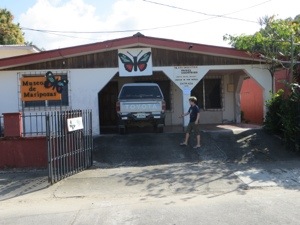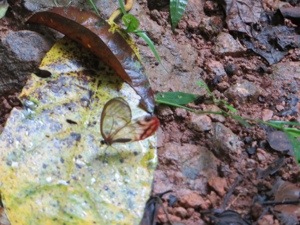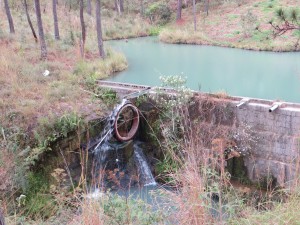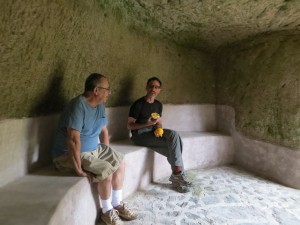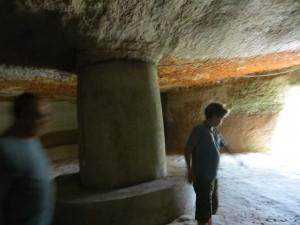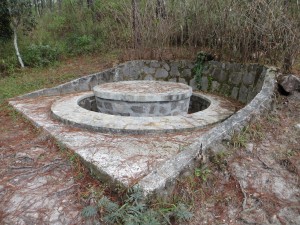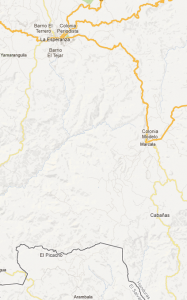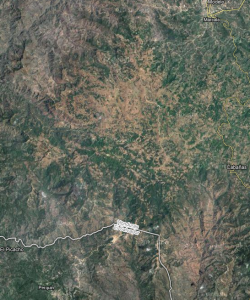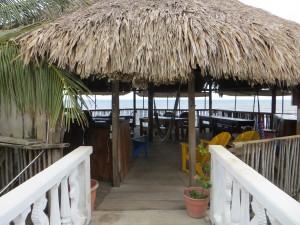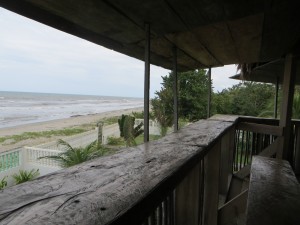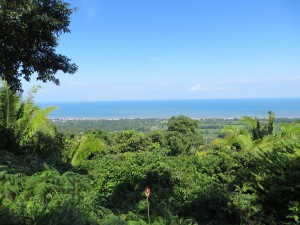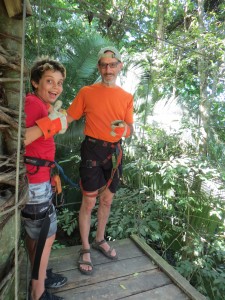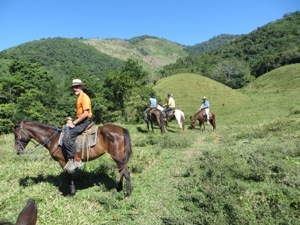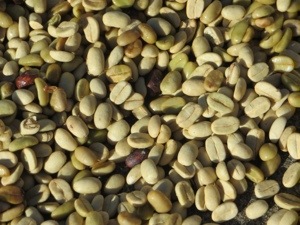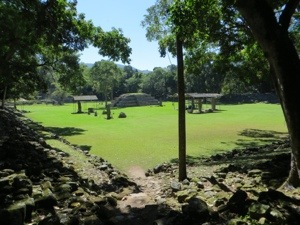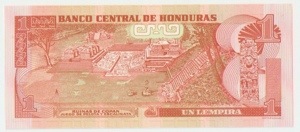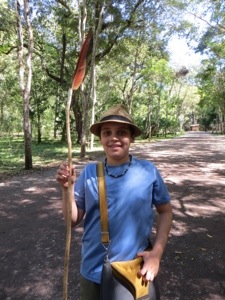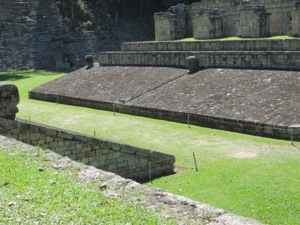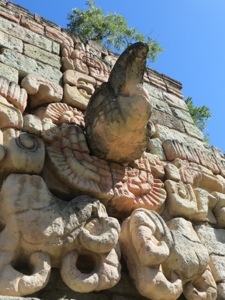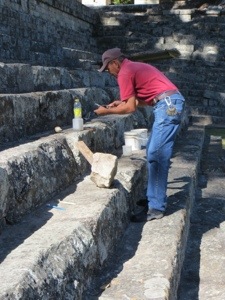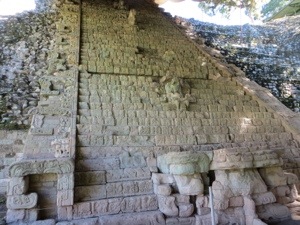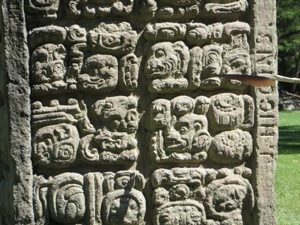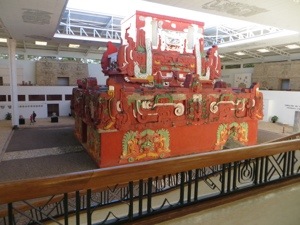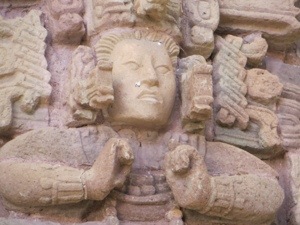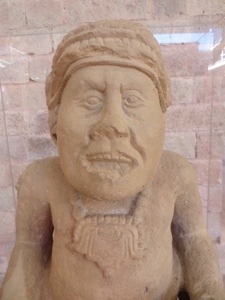As I write this, we are in Santa Ana, El Salvador, waiting while yet another mechanic diagnoses yet another problem with Rocinante. I’m thinking we should, perhaps, have dubbed the car “Man-o’-War” or “Bucephalos” – a name that would have encouraged it to reach for greatness, rather than causing it to live in fear that we might be reaching for a rifle at any moment to put it out of its misery.
I’ll take the opportunity to give you my version of Útila, which contrasts somewhat with that of Scrooge McBeachbum.
He’s right when he says that there’s essentially nothing to do on Útila other than dive or party. The population of visitors skews very young here. We saw lots and lots of skin, much of it inked. Salt-dried, sun-bleached hair; bare feet in in the middle of town, anklets and bracelets made with string and beads. You get the picture. Very few ladies in one-piece bathing suits and sun hats (other than myself, of course) were in evidence.
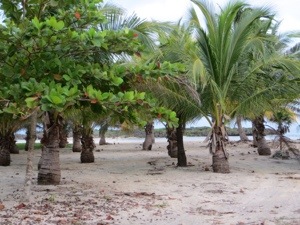
I heard many languages and accents from most of the English-speaking world, but especially Australia, which, given the diving, isn’t surprising. (They have another big reef in Australia, you know.) I also heard a lot of Creole, which wasn’t surprising either, since the nearby island of Roatán was the locus of Garífuna settlement in Central America. The Garífuna people originated in St. Vincent as an admixture of indigenous Arawak and Carib with West Africans from a shipwrecked slaver. They were ousted from St. Vincent when it changed hands in the 18th century, and were resettled in Roatán. The Caribbean coast of Central America from the Moskitia in southern Honduras to the Mexican border is all largely Garífuna; only in Belize do they seem integrated into the general population. In Honduras and Guatemala they are more insular.
But back to the actual island of Útila. The town is (more or less) a single road with dive shops galore, eateries, and a handful of little tiny shops selling island-priced groceries. And lots of hotels. Our host at Sambo Creek, Dante, had arranged a room for us at his friend Phil’s hotel, the Tropical Sunset. It was, I think, the very best hotel room I’ve ever had. It was a large room with two areas, one for Joe and one for us. It had a refrigerator and a nice little table and chairs. It had a large, very comfortable bed and several cozy chairs. It was light and airy, with windows on three sides. It had a little balcony with a porch swing overlooking the Caribbean Sea. It even had a cute and clever little resident monkey, Marcela, who hopped in and out.

It was perfect, but like Camelot, it couldn’t last.
Henry was relaxing on the bed. I was curled up in a comfy chair, reading. Joe was in the bathroom. Marcela ran in, did a little somersault, chattered, and ran back out. A gentle sea breeze wafted in through the French doors. Suddenly, a terrific crash sounded, followed immediately by a panicked cry: “Mom! Dad! Help me!”
Our parental hearts pounding, we rushed to the bathroom. Opening the door, we saw Joe in disarray, a confusion of bits and pieces, and water spouting from the floor. He had leaned back on the toilet only slightly, and the entire tank had burst apart; a huge chunk of porcelain had fallen on a capped fresh water pipe that was (for unknown reasons) sticking out of the floor. The pipe had snapped, and water was gushing out of the bathroom into the room. The shut-off valve was nowhere in evidence.
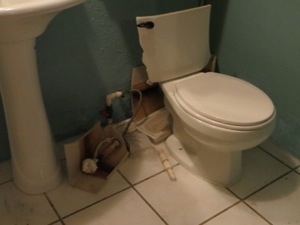
Henry ran around the room, picking up everything on the floor and putting it above sea level. I ran to the hotel office for help. Of course, it was empty and dark, as were all the other rooms in the hotel, as well as the owner’s apartment. At last I found the guard, who roused the manager and the owner. No one could find the shut-off valve. Finally someone located it, but it was too late. Our beautiful room was an inch deep in water, and no longer had a working toilet.

Much laughing and joking of course ensued, addressing Joe’s explosive qualities. It was concluded that there must have been a slight crack in the ceramic caused by a mild earthquake the previous month. Everything was cleaned up, we went to dinner, and when we came back we had a perfectly adequate room that made us very sad.
The next day we all got up very early for our first experience with scuba diving. Henry, not a water person, had decided against the dive, and chose to spend the morning on shore. I would have been just as happy with the (much, much cheaper) snorkeling, but Joe had his heart set on diving, so I agreed to take him.
The “fun dives” work like this: a certified diving instructor (in this case, very blonde Sarah from New York with a tattoo of the legendary whale shark Old Tom on her upper arm) gives you a lecture, complete with flip chart, about the effects of pressure on the human body and the basics of scuba diving apparatus. Then a diving instructor (now Rusty, a very blond Australian with tattoos over most of his torso and, inexplicably, one of those Peruvian knit hats with ear flaps) fits you with a wetsuit, flippers, and a mask, and you head out on the boat with other divers to a shallow area where you can safely practice breathing through the regulator. Joe was a little anxious about this, I could tell, so I encouraged him as best I could, and Rusty made sure that he felt safe. Then we moved out to deeper water.
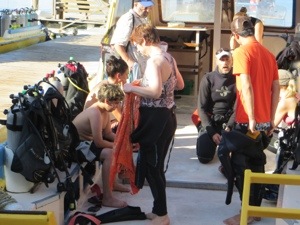
Let me break here to mention that I am a very strong swimmer. I’m not the fastest, but I have an excellent, even stroke, and I am a master at breathing on both sides as I swim. The main reason I am not a Master’s Swimmer is because they always meet way too early in morning. I have good stamina and can swim for hours. I have no fear at all of deep water. I love to be on water of any kind, in any kind of boat. I had no anxiety at all about diving.
When we got to the deeper water, though, I found I couldn’t control sinking very well. As this was a “fun dive,” Rusty had a hand on both of us almost all the time, and really, he was the one doing all the work. But it was a little freaky. Still, I practiced breathing evenly and staying calm–until I suddenly noticed a huge brain coral right beside us. And fish–there were glowing fish, and fluorescent fish, and shimmering fish. There was fan coral waving. There were shapes and color like I never imagined. Up ahead, a ray sailed along the surface of the coral. It was magic.
Until it wasn’t. We paused on a patch of bare sand, and Rusty signaled, just checking that all was well. Joe gave the okay sign. I suddenly realized that I needed to get to the surface, so I signaled “Up,” and up we went. On the surface, I adjusted my mask and breathed normally for a bit, and then we descended again. I checked with myself at the bottom, and I still didn’t feel right. Not exactly panicky, but not okay. We surfaced again, and I felt like that was where I wanted to stay. Rusty was great; he said several times that many people feel uneasy, etc. etc., and it was perfectly normal and okay. It was time to get back to the boat in any case.
When the dive shop boats go out for these fun dives, they generally make two stops; one at the shallow reef, and one at a deeper reef. We had the option, for the second dive, of hanging out on the boat, snorkeling, or going for another dive. Joe didn’t even wait for the end of the question: he wanted to dive. I was very proud of him for being brave enough to dive in the first place, and for not letting my fears make him fearful too. He dove with the group.
I opted for snorkeling, which I enjoyed very much. I saw lots of exotic fish and coral, and I also got to enjoy the boat captain turning up his music and dancing and singing while he waited for the divers. I followed a large school of brilliant blue fish around for a while, and watched six of the divers swimming deep below me. I was floating aimlessly when I saw a little pink bubble near the surface of the water, and then another, and then another, and then I realized that my skin was stinging quite a lot and that I swimming right into a flotilla of pretty pink jellyfish. So then I practiced my fastest crawl in the other direction.
Joe loved his dive so much that he was ready to go again that afternoon. In the end he went for two more dives the following morning (this time with Frankie, an Australian with a navel piercing). He’s been talking about diving ever since. I’m glad he loved it, and glad he has a new interest. I only wish it were something a little cheaper.
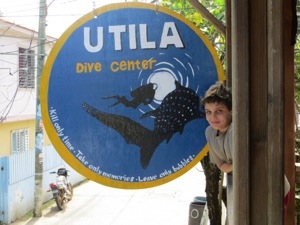
13.898602-89.930336
Like this:
Like Loading...








